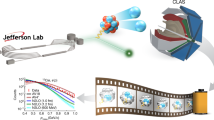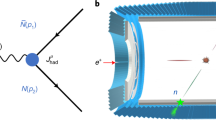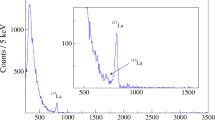Abstract
The atomic nucleus is one of the densest and most complex quantum-mechanical systems in nature. Nuclei account for nearly all the mass of the visible Universe. The properties of individual nucleons (protons and neutrons) in nuclei can be probed by scattering a high-energy particle from the nucleus and detecting this particle after it scatters, often also detecting an additional knocked-out proton. Analysis of electron- and proton-scattering experiments suggests that some nucleons in nuclei form close-proximity neutron–proton pairs1,2,3,4,5,6,7,8,9,10,11,12 with high nucleon momentum, greater than the nuclear Fermi momentum. However, how excess neutrons in neutron-rich nuclei form such close-proximity pairs remains unclear. Here we measure protons and, for the first time, neutrons knocked out of medium-to-heavy nuclei by high-energy electrons and show that the fraction of high-momentum protons increases markedly with the neutron excess in the nucleus, whereas the fraction of high-momentum neutrons decreases slightly. This effect is surprising because in the classical nuclear shell model, protons and neutrons obey Fermi statistics, have little correlation and mostly fill independent energy shells. These high-momentum nucleons in neutron-rich nuclei are important for understanding nuclear parton distribution functions (the partial momentum distribution of the constituents of the nucleon) and changes in the quark distributions of nucleons bound in nuclei (the EMC effect)1,13,14. They are also relevant for the interpretation of neutrino-oscillation measurements15 and understanding of neutron-rich systems such as neutron stars3,16.
This is a preview of subscription content, access via your institution
Access options
Access Nature and 54 other Nature Portfolio journals
Get Nature+, our best-value online-access subscription
$29.99 / 30 days
cancel any time
Subscribe to this journal
Receive 51 print issues and online access
$199.00 per year
only $3.90 per issue
Buy this article
- Purchase on Springer Link
- Instant access to full article PDF
Prices may be subject to local taxes which are calculated during checkout



Similar content being viewed by others
References
Hen, O., Miller, G. A., Piasetzky, E. & Weinstein, L. B. Nucleon–nucleon correlations, short-lived excitations, and the quarks within. Rev. Mod. Phys. 89, 045002 (2017).
degli Atti, C.C. In-medium short-range dynamics of nucleons: recent theoretical and experimental advances. Phys. Rep. 590, 1–85 (2015).
Frankfurt, L., Sargsian, M. & Strikman, M. Recent observation of short-range nucleon correlations in nuclei and their implications for the structure of nuclei and neutron stars. Int. J. Mod. Phys. A 23, 2991–3055 (2008).
Subedi, R. et al. Probing cold dense nuclear matter. Science 320, 1476–1478 (2008).
CLAS Collaboration. Momentum sharing in imbalanced Fermi systems. Science 346, 614 – 617 (2014).
Korover, I. et al. Probing the repulsive core of the nucleon–nucleon interaction via the 4He(e,e′pN) triple-coincidence reaction. Phys. Rev. Lett. 113, 022501 (2014).
Piasetzky, E., Sargsian, M., Frankfurt, L., Strikman, M. & Watson, J. W. Evidence for strong dominance of proton–neutron correlations in nuclei. Phys. Rev. Lett. 97, 162504 (2006).
Tang, A. et al. n–p short-range correlations from (p, 2p + n) measurements. Phys. Rev. Lett. 90, 042301 (2003).
Fomin, N. et al., New measurements of high-momentum nucleons and short-range structures in nuclei. Phys. Rev. Lett. 108, 092502 (2012).
CLAS Collaboration. Measurement of two- and three-nucleon short-range correlation probabilities in nuclei. Phys. Rev. Lett. 96, 082501 (2006).
Frankfurt, L. L., Strikman, M. I., Day, D. B. & Sargsyan, M. Evidence for short-range correlations from high Q 2 (e,e′) reactions. Phys. Rev. C 48, 2451 (1993).
Arrington, J., Higinbotham, D.W., Rosner, G. & Sargsian, M. Hard probes of short-range nucleon–nucleon correlations. Prog. Part. Nucl. Phys. 67, 898–938 (2012).
Weinstein, L. B., Piasetzky, E., Higinbotham, D. W., Gomez, J., Hen, O. & Shneor, R. Short range correlations and the EMC effect. Phys. Rev. Lett. 106, 052301 (2011).
Hen, O., Piasetzky, E. & Weinstein, L.B. New data strengthen the connection between short range correlations and the EMC effect. Phys. Rev. C 85, 047301 (2012).
Gallagher, H., Garvey, G. & Zeller, G. P. Neutrino–nucleus interactions. Annu. Rev. Nucl. Part. Sci. 61, 355–378 (2011).
Li, B. A., Cai, B. J., Chen, L.W. & Xu, J. Nucleon effective masses in neutron-rich matter. Prog. Part. Nucl. Phys. 99, 29–119 (2018).
Caurier, E., Martínez-Pinedo, G., Nowacki, F., Poves, A. & Zuker, A. P. The shell model as a unified view of nuclear structure. Rev. Mod. Phys. 77, 427–488 (2005).
Kelly, J. J. Nucleon knockout by intermediate-energy electrons. Adv. Nucl. Phys. 23, 75–294 (1996).
Dickhoff, W. H. & Barbieri, C. Self-consistent Green’s function method for nuclei and nuclear matter. Prog. Part. Nucl. Phys. 52, 377–496 (2004).
Carlson, J. et al., Quantum Monte Carlo methods for nuclear physics. Rev. Mod. Phys. 87, 1067–1118 (2015).
Frankfurt, L. L. & Strikman, M. I. High-energy phenomena, short-range nuclear structure and QCD. Phys. Rep. 76, 215–347 (1981).
Bogner, S. K. & Roscher, D. High-momentum tails from low-momentum effective theories. Phys. Rev. C 86, 064304 (2012).
More, S. N., Bogner, S. K. & Furnstahl, R. J. Scale dependence of deuteron electrodisintegration. Phys. Rev. C 96, 054004 (2017).
Mecking, B. A. et al. The CEBAF large acceptance spectrometer (CLAS). Nucl. Instrum. Methods A 503, 513–553 (2003).
Wiringa, R. B., Schiavilla, R., Pieper, S. C. & Carlson, J. Nucleon and nucleon-pair momentum distributions in A≤12 nuclei. Phys. Rev. C 89, 024305 (2014).
Sargsian, M.M. New properties of the high-momentum distribution of nucleons in asymmetric nuclei. Phys. Rev. C 89, 034305 (2014).
Ryckebusch, J., Vanhalst, M. & Cosyn, W. Stylized features of single-nucleon momentum distributions. J. Phys. G 42, 055104 (2015).
Rios, A., Polls, A. & Dickhoff, W. H. Depletion of the nuclear Fermi sea. Phys. Rev. C 79, 064308 (2009).
Kortelainen, M. and Suhonen, J. Nuclear matrix elements of 0νββ decay with improved short-range correlations. Phys. Rev. C 76, 024315 (2007).
Frankfurt, L. L., Sargsian, M. M. & Strikman, M. I. Feynman graphs and generalized eikonal approach to high energy knock-out processes. Phys. Rev. C 56, 1124 (1997).
Colle, C., Cosyn, W. & Ryckebusch, J. Final-state interactions in two-nucleon knockout reactions. Phys. Rev. C 93, 034608 (2016).
Colle, C. et al. Extracting the mass dependence and quantum numbers of short-range correlated pairs from A(e,e′p) and A(e, e′pp) scattering. Phys. Rev. C 92, 024604 (2015).
Dutta, D., Hafidi, K. & Strikman, M. Color transparency: past, present and future. Prog. Part. Nucl. Phys. 69, 1–27 (2013).
CLAS Collaboration. Measurement of transparency ratios for protons from short-range correlated pairs. Phys. Lett. B 722, 63–68 (2013).
Shneor, R. et al., Investigation of proton–proton short-range correlations via the 12C(e,e′pp) reaction. Phys. Rev. Lett. 99, 072501 (2007).
Acknowledgements
This work was supported by the US Department of Energy (DOE), contract number DEAC05-06OR23177, under which Jefferson Science Associates, LLC, operates the Thomas Jefferson National Accelerator Facility; by the National Science Foundation, the Israel Science Foundation; the Chilean Comisión Nacional de Investigación Científica y Tecnológica; the French Centre National de la Recherche Scientifique and Commissariat a l’Energie Atomique; the French–American Cultural Exchange; the Italian Istituto Nazionale di Fisica Nucleare; the National Research Foundation of Korea; and the UK Science and Technology Facilities Council.
Reviewer information
Nature thanks T. Aumann, D. Phillips and the other anonymous reviewer(s) for their contribution to the peer review of this work.
Author information
Authors and Affiliations
Consortia
Contributions
The CEBAF large acceptance spectrometer was designed and constructed by the CLAS Collaboration and Jefferson Laboratory. Data processing and calibration, Monte Carlo simulations of the detector and data analyses were performed by a large number of CLAS Collaboration members, who also discussed and approved the scientific results. The analysis presented here was performed by M. Duer with input from O. Hen, E. Piasetzky and L. B. Weinstein and reviewed by the CLAS Collaboration.
Corresponding author
Ethics declarations
Competing interests
The authors declare no competing interests.
Additional information
Publisher’s note: Springer Nature remains neutral with regard to jurisdictional claims in published maps and institutional affiliations.
Supplementary information
Supplementary Information
This file contains Supplementary Text and Data, Supplementary Figures 1–31, Supplementary Tables 1–11 and Supplementary References.
Rights and permissions
About this article
Cite this article
The CLAS Collaboration. Probing high-momentum protons and neutrons in neutron-rich nuclei. Nature 560, 617–621 (2018). https://doi.org/10.1038/s41586-018-0400-z
Received:
Accepted:
Published:
Issue Date:
DOI: https://doi.org/10.1038/s41586-018-0400-z
This article is cited by
-
New extended method for ψ′ scaling function of inclusive electron scattering
Science China Physics, Mechanics & Astronomy (2023)
-
Effects of the momentum dependence of nuclear symmetry potential on pion observables in Sn + Sn collisions at 270 MeV/nucleon
Nuclear Science and Techniques (2022)
-
Many-body factorization and position–momentum equivalence of nuclear short-range correlations
Nature Physics (2021)
-
Understanding Effect of Tensor Interactions on Structure of Light Atomic Nuclei
Few-Body Systems (2021)
-
Nucleon momentum distribution of 56Fe from the axially deformed relativistic mean-field model with nucleon-nucleon correlations
Science China Physics, Mechanics & Astronomy (2021)
Comments
By submitting a comment you agree to abide by our Terms and Community Guidelines. If you find something abusive or that does not comply with our terms or guidelines please flag it as inappropriate.



